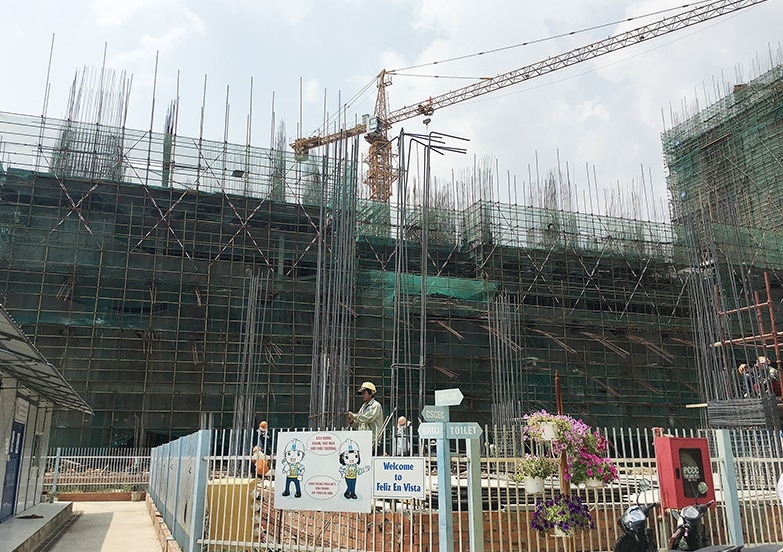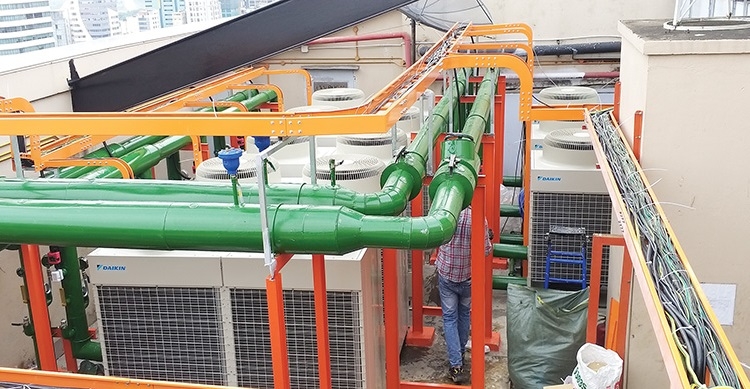Improving efficiencies of using energy in high-rise buildings
 |
| EECB data is being utilised to help specify energy benchmark for varying types of high-rise buildings in the country |
According to statistics, energy consumption in the construction sector accounts for 36-37 per cent of total national energy consumption. With an average power consumption growth rate of 8-10 per cent per year, electricity used in the construction sector, together with its greenhouse gas (GHG) emissions, also increases significantly each year.
In order to minimise the negative effects of the development process and to contribute to the sustainable development of the country, the construction of buildings and cities in a green and smart way has become a common trend.
This trend is contributing to the implementation of the National Determined Contributions (NDC) and the Paris Agreement, according to which GHG emissions will be reduced by 8 per cent by 2030 compared to the business-as-usual scenario (BAU) with domestic resources. The above-mentioned contribution could be increased up to 25 per cent with international support.
The Ministry of Construction (MoC), with the support of the Global Environment Facility through the United Nations Development Programme, has been implementing the EECB project on improving energy efficiency in commercial and high-rise residential buildings in Vietnam in the 2016-2021 period.
The project reduces the intensity of GHG emissions from the construction sector in Vietnam by improving the use of energy from commercial and high-rise apartment buildings in some major cities.
In terms of policy, the MoC has issued the updated version of the National Technical Regulation on Energy Efficient Buildings, regulating the compulsory technical requirements when designing, constructing, or renovating high-rise buildings with a total floor area of 2,500 square metres and above.
For the regulation to come into reality, the EECB scheme is assisting in updating economic and technical norms for the design and construction of buildings, developing construction equipment and material database.
These results enable users to quickly access the latest information on energy efficiency, construction materials, and equipment. At the same time, the project helps promote interest from investors and design consultants in the integration of measures to minimise energy consumption in the building.
 |
| Construction design and equipment are some of the technical aspects being updated thanks to the project |
The EECB project is also co-ordinating research and proposals of mechanisms, policies, and regulations on economical and efficient use of energy in the contents of the amended Law on Construction from June.
This is a significant legal basis to implement activities to promote the development of energy-efficient buildings in Vietnam. The project is also assisting the MoC in studying and developing guidelines to implement the provisions of the law.
In 2019, the EECB initiative surveyed 165 operated buildings of various types, from offices over shopping centres to hotels in Hanoi, Danang, and Ho Chi Minh City to collect data of their energy consumption. The data is being used to develop Specific Energy Consumption (SEC) and energy benchmark for several types of high-rise buildings in Vietnam.
The data also helps owners to self-assess their energy efficiency and give out specific goals to save energy during the operation of the building. This is also the basic data used by researching agencies to set up and develop appropriate policies and solutions to encourage and manage the economical and efficient use of energy in buildings.
In order to support investors in applying energy-saving solutions in specific projects, the EECB project directly provides technical support for a number of operating projects, such as Sofitel Legend Metropole Hanoi and the Somerset Grand Chancelor Building, through the assessment of the current status of energy use and the implementation of solutions on building envelop, fixing and replacing building equipment for energy efficiency.
In addition, the EECB initiative provides technical assistance in the cource of designing, constructing, operating, and monitoring energy consumption for newly-built construction works such as the CONINCO building, and the high-rise residential and commericial building Y1 CapitaLand - Feliz en Vista.
The project’s results are also being summarised into lessons and shared widely for officials of the local departments of construction, the management boards of provincial construction investment projects, and design and construction companies through training workshops and courses held in localities across the nationwide.
To promote activities on economical and efficient use of energy in construction projects, the EECB project will continue to support the MoC and relevant agencies in developing legal documents, mechanisms, and national technical regulations and standards on energy efficiency, promoting green building, and implementing activities of efficient use of energy in construction and the assignments of MoC within the National Energy Efficiency Programme for the period of 2019 to 2030.
What the stars mean:
★ Poor ★ ★ Promising ★★★ Good ★★★★ Very good ★★★★★ Exceptional
Related Contents
Latest News
More News
- Vietnam eases policy approval requirements, simplifies foreign and outbound investments (December 11, 2025 | 17:53)
- Unpacking new momentum in Vietnam’s M&A market (December 10, 2025 | 09:59)
- Forum honours outstanding M&A deals, strategies, and advisory firms (December 09, 2025 | 18:22)
- Vietnam enters defining phase of M&A growth (December 09, 2025 | 17:00)
- Vietnam’s M&A market opens new opportunities amid strong economic momentum (December 09, 2025 | 15:00)
- Vietnam M&A Forum 2025: new position, new momentum (December 09, 2025 | 14:30)
- FDI in Vietnam jumps on additional capital and share purchases (December 09, 2025 | 13:56)
- VIR gathers dealmakers for M&A forum (December 08, 2025 | 17:17)
- Vietnam steps up green transformation with strong policies and rising investment demand (December 06, 2025 | 12:07)
- Listed companies honoured for information transparency (December 06, 2025 | 11:59)

 Tag:
Tag:






















 Mobile Version
Mobile Version